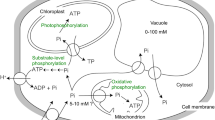Summary
The effect of the external anion concentration on the rate of efflux of anions from corn roots was investigated by following the efflux of labeled anions in shaken solutions of different concentrations of unlabeled anions.
Rates of efflux of phosphate and chloride from corn roots are rather independent of external concentrations of the anions as long as these concentrations are low.
Rates of efflux of phosphate and chloride from corn roots at high external concentrations of these ions were found to be a function of the external concentrations.
Stimulation of efflux is specific: phosphate efflux is stimulated only by phosphate and not by chloride in the medium and vice versa. Since it appears unlikely that this effect is due to specific changes in the permeability of the membranes, it may by concluded that the specific stimulation of efflux by external ions as observed in this investigation is caused by ion exchange at mobile membrane units (Weigl, 1967a). Reasons for this hypothesis are discussed and alternative hypotheses such as that calling for the protoplasm to function as ion exchanger with various specific binding sites are examined. The latter hypothesis remembers to the theory that “the ion carrier is the protoplasm itself” (Overstreet, 1957; Bange and Meijer, 1966), which diminishes the importance of membranes as limiting boundaries.
Zusammenfassung
Der Efflux von Phosphat und Chlorid aus Maiswurzeln in Abhängigkeit von der Außenkonzentration dieser Ionen wurde durch Schütteln der Maiswurzeln in Erlenmeyer-Kolben mit PO4 -oder KCl-Lösungen verschiedener Konzentration untersucht.
Es wurde gefunden, daß der Efflux (bei höheren Außenkonzentrationen) eine Funktion der Außenkonzentration ist. Die Stimulierung des Efflux ist spezifisch und währt mindestens 8 Std. Bei niederen Außenkonzentrationen (unter ungefähr 10-5 M) verschwindet der spezifische Einfluß externer Ionen auf den Efflux.
Es wird wie früher (Weigl, 1967a) angenommen, daß die Stimulierung des Efflux durch Ionenaustausch in einer Membran zustandekommt und daß sich die Austauschstellen (Bindungsstellen) an Membraneinheiten befinden, durch deren “Bewegung” sie durch die Diffusionsschranke geführt werden. Die Gründe für diese Annahme werden erörtert. Eine alternative Theorie wäre, daß das Protoplasma als ganzes als Ionen-Carrier mit vielen spezifischen Bindungsstellen fungiert. Diese Theorie, die die Rolle von Membranen einschränkt, wird gegenwärtig von wenigen Forschern verfochten (Overstreet, 1957; Bange und Meijer, 1966).
Similar content being viewed by others
Literatur
Bange, G. G. J., and C. L. C. Meijer: The alkali cation carrier of barley roots: a macromolecular structure? Acta bot. neerl. 15, 434–450 (1966).
Elzam, O. E., D. W. Rains, and E. Epstein: Ion transport kinetics in plant tissue: complexity of the chloride absorption isotherm. Biochem. biophys. Res. Commun. 15, 273–276 (1964).
Higginbotham, N., B. Etherton, and R. J. Foster: Mineral ion contents and cell transmembrane electropotentials of pea and oat seedling tissue. Plant Physiol. 42, 37–46 (1967).
Hope, A. B., A. Simpson, and N. A. Walker: The efflux of chloride from cells of vitella and chara. Aust. J. biol. Sci. 19, 355–362 (1966).
Jackson, P. C., and D. G. Edwards: Cation effects on chloride fluxes and accumulation levels in barley roots. J. gen. Physiol. 50, 225–241 (1966).
Krichbaum, R., U. Lüttge u. J. Weigl: Mikroautoradiographische Untersuchung der Auswaschung des “anscheinend freien Raumes” von Maiswurzeln. Ber. dtsch. bot. Ges. 80, 167–176 (1967).
Lüttge, U., and G. G. Laties: Absorption and long distance transport by isolated stele of maize roots in relation to the dual mechanism of ion absorption. Planta (Berl.) 74, 173–187 (1967).
Mengel, K.: Stofftransport durch Zellgrenzflächen. In: H. Metzner, Die Zelle. Stuttgart: Wissenschaftliche Verlagsgesellschaft 1966.
—, u. B. Schneider: Die K-Aufnahme als Funktion der Influxrate und der Zellpermeabilität, mathematisch und experimentell an der K-Aufnahme junger Gerstenwurzeln dargestellt. Physiol. Plantarum (Copenh.) 18, 1104–1114 (1965).
Overstreet, R.: Comment on the absorption of inorganic ions by root cells. Plant Physiol. 32, 491–492 (1957).
Pitman, M. G.: The determination of the salt relations of the cytoplasmic phase in cells of beet root tissue. Aust. J. biol. Sci. 16, 647–668 (1963).
Waisel, Y., R. Neumann, and Y. Eshel: The nature of the pH effect on the uptake of rubidium by excised barley roots. Physiol. Plantarum (Copenh.) 19, 115–121 (1966).
Walther, A.: Ein einfaches Verfahren zur Bildung von Differenzialkurven. VDI-Z. 75, 1397–1398 (1931).
Weigl, J.: Die Bedeutung der energiereichen Phosphate bei der Ionenaufnahme durch Wurzeln. Planta (Berl.) 60, 307–321 (1963).
—: Zur Hemmung der aktiven Ionenaufnahme durch Arsenat. Z. Naturforsch. 19b, 646–648 (1964a).
—: Die Phosphataufnahme durch verschiedene Wurzelzonen. Naturwissenschaften 51, 516–517 (1964b).
—: Beweis für die Beteiligung von beweglichen Transportstrukturen (Trägern) beim Ionentransport durch pflanzliche Membranen und die Kinetik des Anionentransports bei Elodea im Licht und Dunkeln. Planta (Berl.) 75, 327–342 (1967a).
—: Wasserstruktur und Permetaion: Die Aktivierungsenergie und der molekulare Mechanismus der Wasserpermeation. Z. Naturforsch. 22b, 885–890 (1967b).
Author information
Authors and Affiliations
Rights and permissions
About this article
Cite this article
Weigl, J. Austausch-Mechanismus des Ionentransports in Pflanzen am Beispiel des Phosphat- und Chloridtransports bei Maiswurzeln. Planta 79, 197–207 (1968). https://doi.org/10.1007/BF00396027
Received:
Issue Date:
DOI: https://doi.org/10.1007/BF00396027




